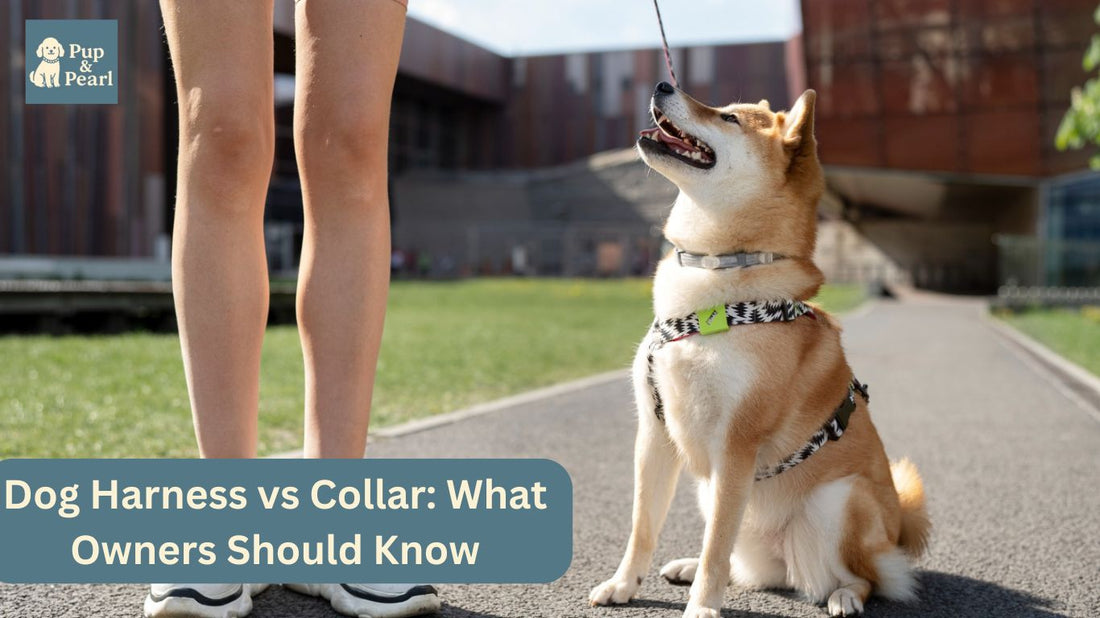
Dog Harness vs Collar: What Owners Should Know
Share
Introduction: the debate between harnesses and collars
For many owners, the choice between a harness and a collar sparks endless deliberation. Each option has its strengths and shortcomings, and the right decision depends on your dog’s unique needs. A carefully chosen walking accessory enhances safety, comfort, and training outcomes.
Understanding the basic function of a dog collar
Collars are the timeless symbol of dog ownership. Worn around the neck, they serve as both identifiers and leash anchors. Simple yet effective, collars remain the most widely used canine accessory worldwide.
Traditional uses of collars in training and identification
Collars have long been favored for obedience training, offering quick correction cues. They also carry identification tags, license information, or medical alerts—practical elements that ensure safety beyond the walk.
Modern innovations in dog collars
Today’s collars often include reflective elements for visibility, GPS trackers for location monitoring, and even smart technology to analyze activity. These modern touches extend their usefulness far beyond tradition.
What is a dog harness and how it differs from a collar
Harnesses take a different approach. By wrapping around the torso, they distribute pressure across the chest and shoulders rather than concentrating force on the neck. This design reduces injury risk for excitable or strong dogs.
Types of harnesses and their unique purposes
Harnesses come in varied forms. Front-clip harnesses discourage pulling. Back-clip versions provide comfort for calm walkers. Step-in harnesses simplify dressing, while no-pull designs offer control over spirited dogs.
Comfort considerations: how collars and harnesses feel to a dog
A collar’s lightweight build makes it easy to wear all day. However, it can irritate sensitive throats during pulling. Harnesses, when properly fitted, reduce neck strain but must avoid restricting natural shoulder movement.
Safety concerns: potential risks of collars vs harnesses
Excessive pressure from collars can harm the trachea or thyroid glands, particularly in smaller dogs. Poorly designed harnesses may rub or cause chafing. Choosing the right fit and inspecting regularly mitigates these risks.
Control and handling: which option provides better management
Harnesses provide greater control, particularly for large breeds or strong pullers. Collars allow quick directional adjustments but offer less leverage. The dog’s temperament largely determines which tool grants better handling.
Health implications for neck, spine, and chest
Pressure from collars affects the cervical spine, while harnesses spread force across the torso. Both must be used correctly to avoid strain. Veterinary experts often recommend harnesses for fragile breeds or those with pre-existing conditions.
Puppies vs adult dogs: which is better at each life stage
Puppies, with delicate necks, benefit from harnesses that protect growing bones. Adult dogs with established leash manners often adapt well to collars, though many still thrive with harnesses for added support.
Breed-specific recommendations: small, large, and brachycephalic dogs
Small breeds and flat-faced dogs struggle with collars, making harnesses the safer choice. Powerful breeds benefit from no-pull harnesses, while medium breeds often adapt to both options comfortably.
Training impact: how harnesses and collars influence behavior
Harnesses minimize strain but may encourage pulling if not paired with proper training. Collars deliver clearer correction cues but can compromise safety if overused. Balanced training ensures success with either.
Practicality: ease of use, putting on and taking off
Collars win for convenience—slip one on, clip a leash, and you’re ready. Harnesses may take longer to secure, though quick-release designs have made the process more user-friendly.
Durability and materials: what to look for in quality gear
Nylon, leather, and neoprene dominate the market. Reinforced stitching, weatherproof finishes, and strong hardware indicate quality. A good harness or collar should endure years of use without failure.
Situational choice: walking, running, traveling, or training
For casual walks, collars suffice. Harnesses excel in high-energy activities such as hiking, running, or car travel, where added stability and support protect your dog. Different situations may call for different tools.
Budget vs premium gear: cost considerations and value
Economical gear covers basic needs but may wear quickly. Premium designs prioritize comfort, longevity, and safety. Investing in quality often proves cost-effective by reducing replacement frequency.
Final thoughts: striking the right balance for your dog
No single answer fits every dog. Collars offer tradition and convenience; harnesses provide safety and control. Many owners use both, depending on context. The wisest choice is guided by your dog’s breed, health, and habits.
For thoughtfully designed essentials that combine style, durability, and comfort, explore Pup & Pearl—crafted with care for discerning pet owners. Shop now to give your companion the very best.
